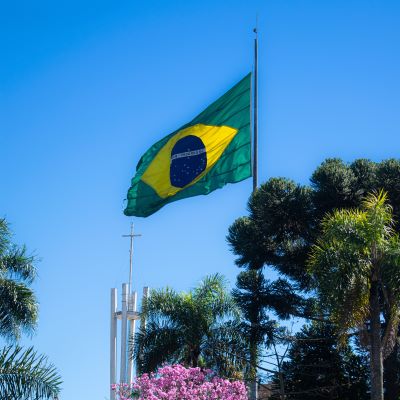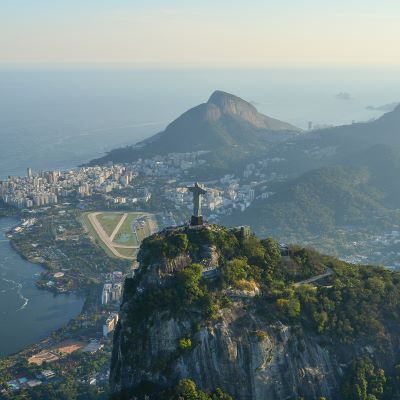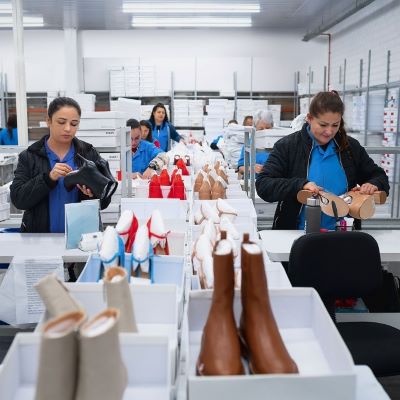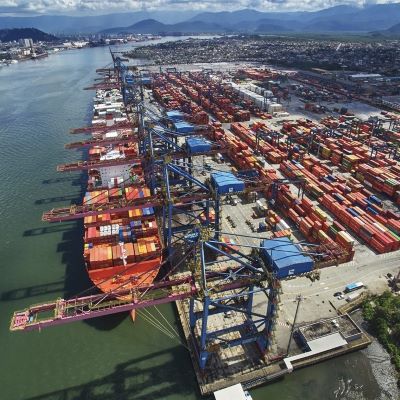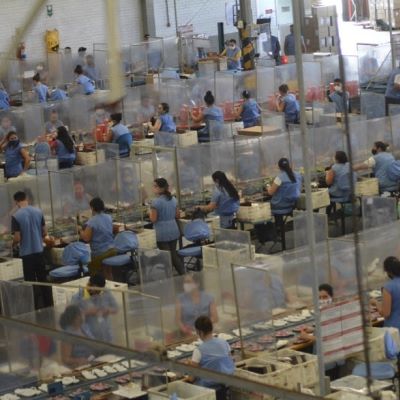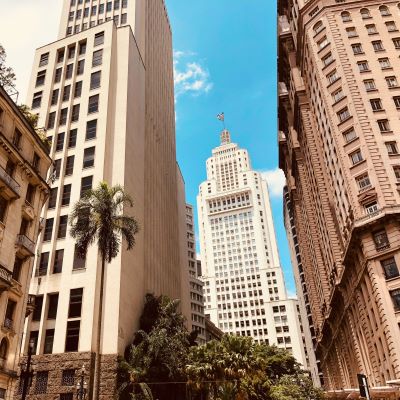World Footwear Voices: interview with Haroldo Ferreira from ABICALÇADOS
Today we bring you a conversation with Haroldo Ferreira, Executive President of ABICALÇADOS, the Brazilian Footwear Industry Association. This is the first episode of the new World Footwear Voices
World Footwear: The World Footwear is in Milan, at MICAM, one of the main international footwear trade fairs. Today, we have with us Haroldo Ferreira from ABICALÇADOS. He is the Executive President of the Brazilian Footwear Industry Association.
World Footwear: Haroldo, what can you tell us about the performance of the Brazilian footwear industry in the first months of 2023?
Haroldo Ferreira: In the first months of this year, we started very positive with growth, but the closure has happened so far in the first half of the year, and 0.5% was lost in production. However, we expect a reversal as the second half of the Brazilian industry is typically more positive than the first. So, we expect to close this year with a production growth between 1.5% and 1.8% over what was registered in 2022.
The most updated forecast of ABICALÇADOS estimates that production should drop by 1.1% in 2023.
World Footwear: In terms of exports, Brazil broke a record last year. How has this year been so far?
Haroldo Ferreira: 2022 was a very positive year for footwear exports from all producing players in the world. We had solid growth. However, this year we will be exporting 9% less compared to the previous year. But this 9% drop is not a negative value for the industry as, even so, we will be exporting more than before the pre-pandemic year (2019). As we know in 2020, 2021 and 2022 there were big fluctuations because of COVID-19. Even though this result seems negative in percentage terms, it is in fact a positive number for the Brazilian footwear exports.
Recent forecasts by ABICALÇADOS indicate that exports should close 2023 with a 12% decline.
World Footwear: What are your main target markets?
Haroldo Ferreira: Historically, the American market has been the largest destination for Brazilian footwear exports. The United States was always in 1st place, Argentina comes in 2nd place, and France in 3rd place. This year there is an inversion between 1st and 2nd place. The United States is in second place and Argentina, surprisingly, is the first destination for Brazilian exports. The United States moved to second place, as it had large import volumes in 2022 from all world producers, ending up in an overstocking situation and now the American economy is giving signs of cooling down and that is why they are buying less footwear this year, and we believe they are reducing orders from all their suppliers.
World Footwear: The domestic market is essential for the Brazilian industry: given the size of the country, the Brazilian industry is very focused on domestic players. How has it been in 2023?
Haroldo Ferreira: 85% of Brazilian footwear production stays in the domestic market. Unlike other producing countries such as, for example, Portugal, whose exports are much higher than domestic consumption. Expectations are positive (for this year) because in the last semester, and especially in the last quarter, consumption of footwear in Brazil typically increases. So, we are expecting a positive 2023 closure regarding consumption in the Brazilian market which is the main destination of national production.
World Footwear: We are in a situation where the Brazilian industry is already experiencing a very significant recovery compared to the impact of COVID-19 and its consequences. What are the main challenges the Brazilian industry is facing at this moment?
Haroldo Ferreira: Even with this growth, we will still not reach pre-pandemic footwear production. As a challenge, the Brazilian footwear industry has a program called: “Sustainable Origin” that works on sustainability. Not only focusing on the ecological product but also focusing on the production processes (raw materials and footwear). We already have 40% of the Brazilian footwear production made by certified companies, many of them exhibiting here at MICAM. So, this is a challenge: expanding this certification because it will allow us to stand out in the production of our products from our main competitors, which are from Asia. This is a big challenge, and we are working together with APEX and the Brazilian government so we can increasingly certify more companies with the “Sustainable Origin” program, which tries to meet the demands of consumers nowadays. As I mentioned this program works on both environmental and social issues. This is important as consumers are increasingly aware of these issues and this is one of the biggest challenges our industry is currently facing.
World Footwear: Did you feel the need to follow this path and look for news solutions driven by consumers? Would you say that it originated from the consumer’s demand for this type of product?
Haroldo Ferreira: Yes. Abicalçados is often approached by importers in the American market asking which companies or products already have some ESG or environmental certification. So, it is a necessity. This program is not new, but during the pandemic it gained strength and was updated with information from environmental programs from all over the world and a specific one was created for the Brazilian industry of raw materials and components.
World Footwear: Currently there is great pressure, worldwide, for companies to work and present results in this area. What other challenges is the Brazilian industry facing? Have you had any issues with labor, such as having qualified labor, for example? How does it work?
Haroldo Ferreira: The footwear industry is starting to face some difficulties in terms of the workforce, which is driven by the traditional model of the industry. However, even though there is a high component of craftsmanship, more and more the industry has been looking for automation processes in activities where that is possible. Transforming an industry that was entirely manufacturing into a more automated one is a challenge for the footwear industry in the world as a whole, and Brazil is not outside of this circuit.
World Footwear: We are at Micam and Brazil has a very significant group of companies exhibiting here. I would like to ask what the importance of participating in such events is and if Brazil is already at pre-pandemic levels in terms of participation in trade fairs or if you still feel that our companies are still dither to participate or if this is no longer a question.
Haroldo Ferreira: We have learned a lot during the pandemic, especially about online connections and digitization, but the importance of face-to-face fairs remains fundamental to doing business and contacting new clients. Digital connection platforms have been created and enhanced during the pandemic (in fact, such platforms already existed, and were boosted with COVID-19), but face-to-face contact will always be important. For someone who is already a customer, they can interact with companies virtually, but for those who do not know the products they will want to touch and feel them, and so the physical contact gains strength. Italy has two main fairs that happen in Milan and Garda and for us it is very important to participate. What will be new in this environment is that as it happens here in Italy and in other countries where the (local) fair is managed by the (local footwear) association, Brazil is changing a 50-year story and from November this year we will have the first edition of BFShow where Abicalçados is the manager of the new trade show.
World Footwear: What are your expectations for this new event that will take place in Brazil?
Haroldo Ferreira: Very positive, the first edition is practically sold out. The main Brazilian brands will be at this fair and not at others. The first edition is in November in Porto Alegre, the second edition will be in May 2024 in São Paulo, and this will be a bigger fair because it will present summer products. So, our expectation is very positive, and our view is that in Latin America, the main fair will be BFShow, which is run by the Brazilian Footwear Association.
Haroldo Ferreira: Historically, the American market has been the largest destination for Brazilian footwear exports. The United States was always in 1st place, Argentina comes in 2nd place, and France in 3rd place. This year there is an inversion between 1st and 2nd place. The United States is in second place and Argentina, surprisingly, is the first destination for Brazilian exports. The United States moved to second place, as it had large import volumes in 2022 from all world producers, ending up in an overstocking situation and now the American economy is giving signs of cooling down and that is why they are buying less footwear this year, and we believe they are reducing orders from all their suppliers.
World Footwear: The domestic market is essential for the Brazilian industry: given the size of the country, the Brazilian industry is very focused on domestic players. How has it been in 2023?
Haroldo Ferreira: 85% of Brazilian footwear production stays in the domestic market. Unlike other producing countries such as, for example, Portugal, whose exports are much higher than domestic consumption. Expectations are positive (for this year) because in the last semester, and especially in the last quarter, consumption of footwear in Brazil typically increases. So, we are expecting a positive 2023 closure regarding consumption in the Brazilian market which is the main destination of national production.
World Footwear: We are in a situation where the Brazilian industry is already experiencing a very significant recovery compared to the impact of COVID-19 and its consequences. What are the main challenges the Brazilian industry is facing at this moment?
Haroldo Ferreira: Even with this growth, we will still not reach pre-pandemic footwear production. As a challenge, the Brazilian footwear industry has a program called: “Sustainable Origin” that works on sustainability. Not only focusing on the ecological product but also focusing on the production processes (raw materials and footwear). We already have 40% of the Brazilian footwear production made by certified companies, many of them exhibiting here at MICAM. So, this is a challenge: expanding this certification because it will allow us to stand out in the production of our products from our main competitors, which are from Asia. This is a big challenge, and we are working together with APEX and the Brazilian government so we can increasingly certify more companies with the “Sustainable Origin” program, which tries to meet the demands of consumers nowadays. As I mentioned this program works on both environmental and social issues. This is important as consumers are increasingly aware of these issues and this is one of the biggest challenges our industry is currently facing.
World Footwear: Did you feel the need to follow this path and look for news solutions driven by consumers? Would you say that it originated from the consumer’s demand for this type of product?
Haroldo Ferreira: Yes. Abicalçados is often approached by importers in the American market asking which companies or products already have some ESG or environmental certification. So, it is a necessity. This program is not new, but during the pandemic it gained strength and was updated with information from environmental programs from all over the world and a specific one was created for the Brazilian industry of raw materials and components.
World Footwear: Currently there is great pressure, worldwide, for companies to work and present results in this area. What other challenges is the Brazilian industry facing? Have you had any issues with labor, such as having qualified labor, for example? How does it work?
Haroldo Ferreira: The footwear industry is starting to face some difficulties in terms of the workforce, which is driven by the traditional model of the industry. However, even though there is a high component of craftsmanship, more and more the industry has been looking for automation processes in activities where that is possible. Transforming an industry that was entirely manufacturing into a more automated one is a challenge for the footwear industry in the world as a whole, and Brazil is not outside of this circuit.
World Footwear: We are at Micam and Brazil has a very significant group of companies exhibiting here. I would like to ask what the importance of participating in such events is and if Brazil is already at pre-pandemic levels in terms of participation in trade fairs or if you still feel that our companies are still dither to participate or if this is no longer a question.
Haroldo Ferreira: We have learned a lot during the pandemic, especially about online connections and digitization, but the importance of face-to-face fairs remains fundamental to doing business and contacting new clients. Digital connection platforms have been created and enhanced during the pandemic (in fact, such platforms already existed, and were boosted with COVID-19), but face-to-face contact will always be important. For someone who is already a customer, they can interact with companies virtually, but for those who do not know the products they will want to touch and feel them, and so the physical contact gains strength. Italy has two main fairs that happen in Milan and Garda and for us it is very important to participate. What will be new in this environment is that as it happens here in Italy and in other countries where the (local) fair is managed by the (local footwear) association, Brazil is changing a 50-year story and from November this year we will have the first edition of BFShow where Abicalçados is the manager of the new trade show.
World Footwear: What are your expectations for this new event that will take place in Brazil?
Haroldo Ferreira: Very positive, the first edition is practically sold out. The main Brazilian brands will be at this fair and not at others. The first edition is in November in Porto Alegre, the second edition will be in May 2024 in São Paulo, and this will be a bigger fair because it will present summer products. So, our expectation is very positive, and our view is that in Latin America, the main fair will be BFShow, which is run by the Brazilian Footwear Association.
This interview was conducted in September 2023. The BFSHOW took place in November already.
World Footwear: Is that your main target in terms of visitors? Will it be a fair that wants to attract neighboring countries, or do you aim to be an international fair?Haroldo Ferreira: Brazil has always been sought after by importers from all over the world. Micam is the main fair of this industry, but after the Italian fairs we will position ourselves as one of the main fair players and we will attract buyers from all over the world.
World Footwear: Finally, what are the expectations, not only for the Brazilian industry, but for the footwear industry worldwide? What can we expect in the coming years? If I asked this question a few years ago, no one would say COVID-19, war in Europe,... But from what we can predict, what do you expect will impact the footwear industry both in Brazil and in the rest of the world?
Haroldo Ferreira: I have two points to refer. The first point involves technology, both in manufacturing and in the product, ensuring products have a more sustainable appeal. This is a challenge for all industries, including footwear. And the other is related to the social element and the (higher) respect that the Western industry has for their workers. These are the two points that will most differentiate us (Brazil and the other producing countries from the Western industry). We will have to bring the consumer’s attention to this: to let them know they are buying a product that was manufactured in a responsible way, socially and environmentally. In my view, this is a challenge for the worldwide footwear industry, mainly for Western countries.
World Footwear: Thank you very much Haroldo.
World Footwear: These were the main ideas from the Brazilian footwear industry. Follow the worldfootwear.com for more updates about the worldwide footwear industry.
This interview was conducted in Milan in September 2023 during the Micam


